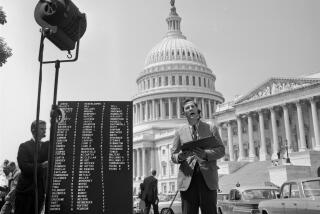‘The American: A Fourth of July Tribute’
- Share via
“He seized the lightning from heaven and the scepter from tyrants.”
Boston, 1711.
It was the middle of the night. A terrible fork of lightning illuminated the small room and moments later deafening thunder boomed. Five-year-old Ben’s brothers and sisters ran for cover.
But Ben didn’t run. He gazed at the sky in fascination.
Off in the distance, lightning had struck a house.
Josiah, Ben’s father, came into the room and saw the house burning.
He said solemnly. “It is the will of God.”
“Our neighbors house is burning and it is the will of God, father? Why?” asked little Ben.
“No one questions the will of the Almighty, son.”
His father’s words filled Ben with wonderment and he felt bad for his neighbors.
In these times, people’s houses were frequently destroyed by a fire created by lightning.
Abiah, Ben’s mother, bustled into the room. She quieted the younger children and read them all an Aesop’s Fable by candlelight.
There were 17 children. At the age of 8 Ben went to school for one year. At the age of 10, he was put to work. But Ben loved to read. And though his way was difficult, he became a success and eventually one of the richest men in the British colonies in America.
In 1749, at the age of 43, he retired and began scientific experiments.
Ben remembered his fascination with thunderstorms. He believed lightning was electricity.
Most scientists of the day already believed that lightning was electricity, but they didn’t know why and they couldn’t prove it.
Ben believed that the thunderclouds were full of water and when these clouds were hit by high winds, it was this that created the electricity that escaped from the clouds in the form of lightning.
He proved this by flying a kite with a metal key attached to it in an electrical storm. He succeeded in electrifying the metal key. He was lucky not to be injured as this experiment is very dangerous.
He was the first man in the world to prove that lightning was electricity.
This experiment led to his invention of the lightning rod.
What is a lightning rod?
It is a pointed piece of metal sunk in the ground, attached to people’s houses. It attracts the electrical impulses of lightning to the metal and away from the building. The metal absorbs all the electrical impulses the lightning can give. And since metal does not burn, houses were safe from fire.
Because of this invention, people would never again have the fear that their homes would be destroyed by “the will of God” or the force of a lightning bolt.
Ben gave his idea away, free of charge. And so Ben and his lightning rod became a worldwide symbol of America’s independence, benevolence and ingenuity.
About 30 years later, in 1776, America decided to break with England. The King was a tyrant so the break was necessary in order to insure Americans the rights of “life, liberty and the pursuit of happiness.” At the time, England was the most powerful country on Earth.
The 70-year-old Ben helped to write, as well as sign, the document that declared America to be an independent country, no longer dominated by England. It was called the Declaration of Independence. Many of the wealthiest and most influential citizens of America signed this document.
Ben said, “We must all hang together, or assuredly we shall all hang separately.”
Why would he say this? Because anyone signing it took his life in his hands. His signature was an act of treason against England.
Why would a wealthy man take this kind of risk?
Thomas Paine, another Founding Father said, “Those who expect to reap the blessings of freedom must, like men, undergo the fatigue of supporting it.”
And in Ben’s words, “Any society that would give up a little liberty to gain a little security will deserve neither and lose both.”
Ben, of course, was Benjamin Franklin, one of America’s Founding Fathers. He symbolized the best that America has to offer. Benjamin Franklin was America.
To learn about electrical safety, visit https://kids.esfi.org/
To learn more about Benjamin Franklin, visit ushistory.org/franklin.
Recommended reading: “Benjamin Franklin, American Genius: His Life and Ideas with 21 Activities” by Brandon Marie Miller.
“A Picture Book of Benjamin Franklin” by David Adler.
“Now & Ben: The Modern Inventions of Benjamin Franklin” by Gene Barretta.
Sunday, July 4, is Independence Day.
More to Read
Sign up for Essential California
The most important California stories and recommendations in your inbox every morning.
You may occasionally receive promotional content from the Los Angeles Times.












